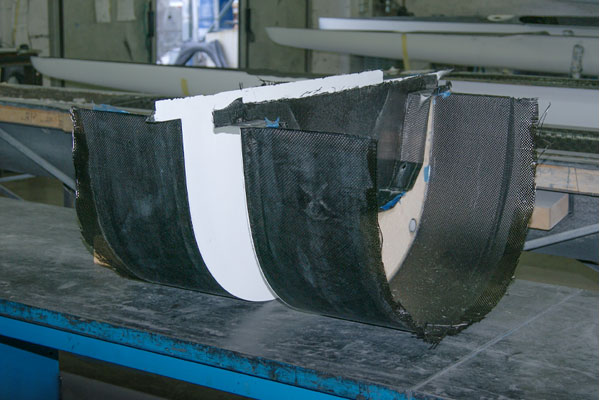You don’t get on top of the world by pure chance. If, thanks to New Zealand, Filippi reached it with 8+ on a venue like the Sea Forest Waterway in Tokyo – which, for hydrodynamic reasons, subjects the materials to unprecedented stress – it means that no detail was neglected behind the scenes. As the engineers at the Filippi Lab teach us, when they analyze virtual data and real tests on every centimeter of our boats on the computer, you cannot think of intervening on one aspect of the construction of a model while neglecting the whole.

This is how we operate in the Filippi’s backstage: in the case of the Eight, the preventive simulations of the FEM (i.e., relating to the analysis of the finite elements of mechanical models) made it possible to identify deformations which, by not following a continuous curve, produced an increase in the boundary layer of water particles attached to the hull in certain areas of the boat. The result? An increase in resistance.
Since
we are not dealing with isotropic materials such as steel or aluminum
(whose mechanical features are identical in all directions) but
orthotropic materials such as composites (in which different behaviors
occur for each lamination layer), it was not obvious to correct the
artifact, which must be evaluated in its entirety.
To do this, it
was mandatory to compare the simulation of application of the gluing,
rather than the characteristics of the single materials, with dozens of
real stratification tests carried out in our labs or, on our behalf, by
universities such as that of Messina. Test results also had to be
subjected to resolutive software such as Siemens’ Nastran, which
validated the actions on the model. Considering that every boat is
customized even in terms of stiffening, imagine the work behind it. Not
to mention the fluid-dynamic part, which includes the boat's geometry,
the loads produced by the athletes and the constraints, such as the
resistance in the water.
It wasn’t about a generic checking, but centimeter-by-centimeter tests: to be precise, every 3 millimeters of the boat and up to a tenth of a millimeter. This is the case of our sandwich, made of very thin layers that lead to variable results. The very fact that each place of fabric that is superimposed on the other behaves differently gives an idea of the difficulties to face in the actions taken on the project's so-called “weak points”.
In fact, imagine the boat broken down into a series of different triangles, each with its first and last name according to position and type of stratification (finite elements). Then add the loads, i.e., the forces (like the oar and the athlete) transmitted to the hull and the resistance produced by the water.
All these values put together can create non-constant deformed curves on the computer, which must be interpreted as discontinuity of the water pressure. It is then necessary to intervene and improve the performance of the boat. However, we were not satisfied with knowing the consistency of all boat areas and entrusting them to the computerized analysis of the finished product. That result was optimized with a real test, which gave the study of the elements and the artifact their current appearance.

How the section of the Eight has changed
One of the points we focused on more is that of the demountable which, by nature, produces a discontinuity in the profile of the Filippi’s Eight.
The studies we carried out have imposed changes to the sectioning system, as we found that the application of the loads on the water level produced a strange “curve” in the computer analysis, synonymous with a translation of the two faces of the section of Eight that are not visible to the naked eye.
At this point, the goal became to facilitate assembly with references so precise as to make errors in that sense practically impossible. The problem was mainly related to the imperfect centering of the fixing holes of the bow and stern section, which didn’t allow a symmetrical transmission of the loads. The intervention was radical: replacing the 17-millimeter marine plywood cavity with one of 25-millimeter PVC on each side. Hence their carbon stratification and subsequent drilling of the nine connection holes with a numerical control machine, where nuts and bolts are housed.

With the same accuracy, it was possible to place the 316L steel threaded bushing in the cavities, whose role (given their infinite duration) is to ensure the transfer of loads to the section over time, preventing the bolts from causing crushing.
Now we had the perfect distance between the screw head and the coupling of the two parts of the section and, even in the case of anomalous loads, the screw cannot twist. It will always remain perpendicular to the face of the demountable. This equates to great ease of coupling and slack of the nine screws of less than 1/10, an almost unattainable level of mechanical precision. Essentially, no possibility of translation and, therefore, the guarantee of the absolute reliability of an epochal success.

